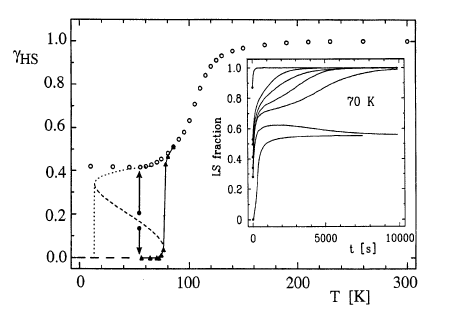
|
Photophysics and Photochemistry of Transition Metal Compounds |
| Home Research Members Collaborations Publications |

|
 |
|||||||
In iron(II) spin-crossover compounds, the transition from the 1A1 low-spin state at low temperatures to the 5T2 high-spin state at elevated temperatures is accompanied by a large increase in metal-ligand bond lengths. The resulting elastic interactions may be pictured as an internal pressure which is proportional to the concentration of the low-spin species. Because pressure stabilises the low-spin state relative to the high-spin state this results in a positive feedback. Thermal transition curves in neat iron(II) spin-crossover compounds are thus invariable much steeper than in diluted mixed crystals, and the high-spinâlow-spin relaxation following the light-induced population of the high-spin state at low temperatures is self-accelerating. Strong interactions give rise to a thermal hysteresis, and light-induced bistabilities may be observed for compounds with initially a high-spin ground state and the potential for a light-induced population of the low-spin state. For such compounds, the increasing internal pressure may stabilise the low-spin state sufficiently so that it becomes the molecular ground state above some critical light-induced low-spin fraction. Secondary effects of the elastic interactions include crystallographic phase transitions, inhomogeneous distributions of sites, and anomalies such as steps in the transition curve. | ||||||||
|
||||||||
The iron(II) spin-crossover compound [Fe(ptz)6](PF6)2 (ptz = 1-propyltetrazole) crystallizes in the triclinic space group Pâ , with a = 10.6439(4) Ã
, b = 10.8685(4) Ã
, c = 11.7014(4) Ã
, α = 75.644(1)°, β = 71.671(1)°, γ = 60.815(1)°, and Z = 1. In [Fe(ptz)6](PF6)2, the thermal spin transition is extremely steep because of cooperative effects of elastic origin. The transition temperature at ambient pressure is 74(1) K. An external pressure of 1 kbar shifts the transition temperature to 102(1) K, corresponding to a stabilization of the low-spin state, which is smaller in volume. The volume difference between the high-spin and the low-spin state, ÎV°HL, is 24(2) Ã
3/molecule. The interaction constant Î, as a measure of cooperativity, is within experimental error independent of external pressure and has a value of 101(5) cm-1. In contrast to the case of the related compound [Fe(ptz)6](BF4)2 (Decurtins et al. Inorg. Chem. 1985, 24, 2174), there is no hysteresis due to a first-order crystallographic phase transition, nor is there a hysteresis induced by external pressure as in the mixed crystal [Zn1-xFex(ptz)6](BF4)2, x = 0.1 (JeftiÄ et al. J. Phys. Chem. Solids 1996, 57, 1743). However, in [Fe(ptz)6](PF6)2, the interaction constant Î is found to be very close to the critical value above which a hysteresis solely due to the cooperative effects is expected. In addition, high-spin â low-spin relaxation measurements were performed under external pressures of up to 1 kbar in the temperature interval between 50 and 60 K. An external pressure of 1 kbar accelerates the high-spin â low-spin relaxation by 1 order of magnitude. | ||||||||
|
||||||||
In the [Fe(etz)6](BF4)2 spincrossover system the iron(II) complexes occupy two nonequivalent lattice sites, sites A and B. Complexes on site A show a thermal high-spin (HS) â low-spin (LS) transition at 105 K, whereas complexes on site B remain in the HS state down to 10 K. Complexes on both sites exhibit light-induced spin state conversions (LIESST) at 20 K: LS â HS on site A with λ = 514.5 nm, and HS â LS on site B with λ = 820 nm. The relaxation processes subsequent to the HS â LS conversion on site B reveal a light-induced HSâLS bistability for the complexes on site B at 70 K. The bistability as well as the absence of a thermal spin transition on site B are attributed to a thermal hysteresis for the B-site complexes with a critical temperature Tâc K on heating. This hysteresis can be interpreted in terms of strong cooperative effects of elastic origin, which, in addition, cause characteristic deviations of the relaxation on site B from first-order kinetics (self-acceleration). In contrast, the HS â LS relaxation at 60 K on site A after irradiation with λ = 514.5 nm shows an unusual self-retardation. | ||||||||
|
||||||||
The [Fe(etz),](BF,), spin-cross-over system (etz = 1-ethyl-1Â H-tetrazole) crystallizes in space group P1, with the following lattice constants at 298 K:Â a10.419(3), b=15.709(1), c = 18.890(2) Ã
, α = 71.223(9), β =77.986(10), and γ = 84.62(1)° V = 2862.0(9) Ã
3 and Z = 3. Two nonequivalent lattice sites, one without (site A) and one with (site B) inversion symmetry, are observed. The population of the two sites nA:nB is 2:l. Iron(II) on site A undergoes a thermal low-spin (LS) â high-spin (HS) transition with T1/2I, = 105 K. whereas that on site B remains in the high-spin state down to cryogenic temperatures. Application of external pressure of up to 1200 bar between 200 and 60 K does not cause formation of the low-spin state on site B. On site A the high-spin state can be populated as a metastable state at 20 K by irradiating the sample with λ = 514.5 nm; on site B a light-induced population of the low-spin state can be achieved with λ = 820 nm. | ||||||||
|
Download this list in format RIS
 EndNote
EndNote  BibTex
BibTex  PDF XML
PDF XML Last update Friday December 08 2017